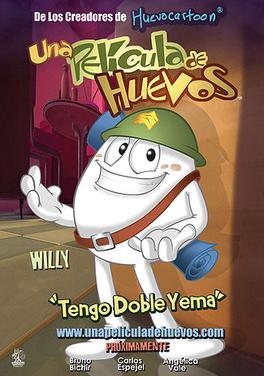Una película de huevos
Una película de huevos is a 2006 Mexican animated comedy film directed by Rodolfo Riva Palacio Alatriste and Gabriel Riva Palacio Alatriste. The film is notable for being one of the first major animated feature films produced entirely in Mexico, marking a significant milestone in the Mexican film industry. It combines humor, adventure, and a unique storytelling approach to capture the audience's imagination.
Plot[edit | edit source]
The story revolves around Toto, a young chicken (Gallus gallus domesticus) who is determined to avoid the fate of being cooked and eaten. Upon learning that he can avoid this fate by becoming a rooster, Toto, along with his friends Willy, a rooster, and Bibi, a duck, embark on an adventurous journey to achieve his dream. Their quest is filled with challenges, humorous encounters, and lessons about friendship, courage, and the importance of pursuing one's dreams.
Production[edit | edit source]
The production of Una película de huevos showcased the talents of Mexican animators and storytellers. The film was produced by Huevocartoon Producciones, a company known for its humorous and satirical animated shorts that gained popularity on the internet. The transition from short web animations to a full-length feature film was a significant achievement for Huevocartoon and demonstrated the potential of Mexican animation on a larger scale.
Reception[edit | edit source]
Upon its release, Una película de huevos received positive reviews from both audiences and critics. It was praised for its originality, humor, and the way it showcased Mexican culture through animation. The film's success led to the production of sequels, further establishing the franchise in the Mexican film industry.
Legacy[edit | edit source]
Una película de huevos has left a lasting impact on the Mexican animation industry, inspiring other filmmakers and animators to pursue their projects. It demonstrated that with creativity and dedication, Mexican animation could compete on an international level. The film and its sequels have become beloved by audiences of all ages, cementing its place in Mexican cinema history.
Search WikiMD
Ad.Tired of being Overweight? Try W8MD's physician weight loss program.
Semaglutide (Ozempic / Wegovy and Tirzepatide (Mounjaro / Zepbound) available.
Advertise on WikiMD
|
WikiMD's Wellness Encyclopedia |
| Let Food Be Thy Medicine Medicine Thy Food - Hippocrates |
Translate this page: - East Asian
中文,
日本,
한국어,
South Asian
हिन्दी,
தமிழ்,
తెలుగు,
Urdu,
ಕನ್ನಡ,
Southeast Asian
Indonesian,
Vietnamese,
Thai,
မြန်မာဘာသာ,
বাংলা
European
español,
Deutsch,
français,
Greek,
português do Brasil,
polski,
română,
русский,
Nederlands,
norsk,
svenska,
suomi,
Italian
Middle Eastern & African
عربى,
Turkish,
Persian,
Hebrew,
Afrikaans,
isiZulu,
Kiswahili,
Other
Bulgarian,
Hungarian,
Czech,
Swedish,
മലയാളം,
मराठी,
ਪੰਜਾਬੀ,
ગુજરાતી,
Portuguese,
Ukrainian
Medical Disclaimer: WikiMD is not a substitute for professional medical advice. The information on WikiMD is provided as an information resource only, may be incorrect, outdated or misleading, and is not to be used or relied on for any diagnostic or treatment purposes. Please consult your health care provider before making any healthcare decisions or for guidance about a specific medical condition. WikiMD expressly disclaims responsibility, and shall have no liability, for any damages, loss, injury, or liability whatsoever suffered as a result of your reliance on the information contained in this site. By visiting this site you agree to the foregoing terms and conditions, which may from time to time be changed or supplemented by WikiMD. If you do not agree to the foregoing terms and conditions, you should not enter or use this site. See full disclaimer.
Credits:Most images are courtesy of Wikimedia commons, and templates, categories Wikipedia, licensed under CC BY SA or similar.
Contributors: Prab R. Tumpati, MD

